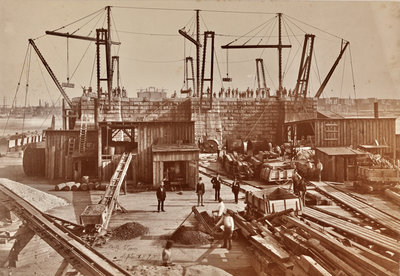The Brooklyn Bridge changed this past week, as elected officials and cyclists celebrated a new dedicated bike lane on the Manhattan-bound side of the bridge.
It marked the first reconfiguration of the Brooklyn Bridge since the last trolley tracks were ripped up in 1950, yet it is far from the first time that New Yorkers have watched intently as the bridge made history.
The Brooklyn Bridge has existed in many different forms and configurations over its history, capturing the imaginations of innumerable tourists, commuters, and history buffs, including Green-Wood Cemetery’s resident historian Jeff Richman.
For over 40 years, Richman has been accruing a vast array of visual media about the construction of the Brooklyn Bridge.
In that time he has come across original architectural drawings, woodcuts, 3D steroview images, photographs, and much more.
The decades of collection are culminating with the release of Richman’s new book, “Building the Brooklyn Bridge, 1869-1883: An Illustrated History, with Images in 3D,” due out on October 6.
Featuring 253 19th-century images, the book explores the history of the bridge’s construction, how the process was chronicled in visual media, and why the Brooklyn Bridge has become the defining symbol of the borough it looms over.
“There’s an interesting interplay between these various types of images and the construction of the bridge,” Richman said.
The Brooklyn Bridge was built between 1869 and 1883, a 14-year-span during which a number of new technologies were developed that offered the general public novel ways to follow the construction process.
“The ability to reproduce photographs in mass for a newspaper did not exist until about 1880, they could not take a photograph that was shot in 1872 at the bridge and print it,” Richman explained. “So they used woodcuts. They would take the photograph, or the artists would go out to the spot, and draw the scene, and then they would translate it into a woodcut that could be printed.
“The woodcuts have a strength that the architectural drawings don’t, which is that they were made to be easy to read, and to emphasize certain action,” he added.
Even as the technology to produce photographs became refined, the mere act of photographing the bridge was often enough to be featured in local and national newspapers.
“Back then you were dealing with large bulky cameras,” Richman said. “So when a photographer carried his camera up to the top of the tower of the Brooklyn Bridge, it was news in a newspaper. Today that would not be news because the photographs would certainly show up on Instagram, Facebook, or wherever.”
Richman is particularly excited to share his collection of stereoviews, a 19th century technology that uses a special viewer to give two images on a slide the appearance of a single 3D image.
A pair of 3D glasses is included in every copy of “Building the Brooklyn Bridge” so readers can also experience this unique visual format.
“Stereoviews were really a kind of multimedia center for family life and parlor life in the Victorian era,” Richmand said. “You could be in Ohio or California and still follow the construction of the bridge in 3D.
“Today we kind of take for granted the billions and billions of photographs that are turned out in a very short period of time,” he added. “Back then, it was new for people to have several different media opportunities to see what would soon be proclaimed the eighth wonder of the world.”
With so many people following its construction, the Brooklyn Bridge became a de facto symbol for the various technological innovations of the era.
“It was seen as progress, it was seen as something that had never been done before,” Richman said. “It was longer than any suspension bridge that had been built before. It was all steel, which was an innovation. It was the first bridge that had electric lights going across the East River.
“There’s really a comparison I think to the space program and the idea that you do it because the thing is worth doing,” he added. “At the same time, you do it because it will make other similar things possible by learning from the experience of the bridge construction.”
When it opened in 1883, thousands of people in Brooklyn and Manhattan celebrated the first bridge uniting what were then two separate cities. The new connection literally and symbolically linked the populations on both sides of the river, paving the way for the massive and culturally unified New York City we know today.
“From the Manhattan perspective, you’re looking at Brooklyn as this vast open space where Manhattan could expand,” Richman explained. “By the same token, Brooklynites dating back to the beginning of the 19th century with Henry Pierpont were establishing Brooklyn as a suburb from which you commute by ferry to Manhattan to work.
“Remarkably, 9 million people commuted across the Brooklyn bridge in its first year of operation,” he added. “The next year it was 20 million. There was a tremendous demand for people to be able to live in Brooklyn but work in Manhattan.”
Since the Brooklyn Bridge’s opening, the borough for which it is named has grown exponentially. But Richman is certain that no other structure in the borough will ever come to rival the engineering genius, visual splendor, and symbolic power of the Brooklyn Bridge.
“The bridge was immediately an icon and remains an icon today,” Richman said. “The Brooklyn Bridge is a universal, easily read, unmistakable symbol of New York City. I think that it holds a unique position and will continue to hold that unique position.”



